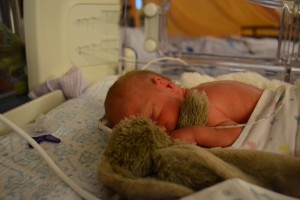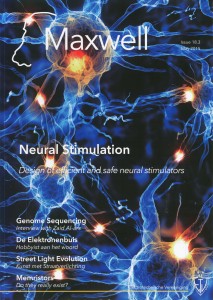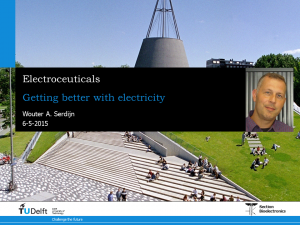Kleine, draadloze en intelligente implantaten die werken als elektronisch medicijn, dat is de droom van Wouter Serdijn. Serdijn hield deze week aan de TU Delft zijn intreerede als hoogleraar bio-electronica. Hij noemt zulke implantaten ‘electroceuticals’, als tegenhanger van de ‘farmaceuticals’, ofwel pilletjes. Het idee is eenvoudig: waar pilletjes de biochemische activiteit van lichaamscellen veranderen, veranderen electroceuticals de elektrische activiteit.
De moleculen uit een pilletje komen via de bloedbaan in het hele lichaam terecht. De effecten treden niet direct op, zijn niet lokaal en ook niet meteen omkeerbaar. Bovendien hebben pilletjes vaak ongewenste bijeffecten. Maar eeuwenlang was er geen andere mogelijkheid.
Micro-electronica heeft hier verandering in gebracht. Zo kunnen sinds een jaar of tien patiënten met ernstige Parkinson of depressie behandeld worden met een hersenimplantaat dat lokaal in de hersenen elektrische pulsjes genereert. ‘Deze implantaten hebben echter flink wat nadelen’, vertelt Serdijn een dag voor zijn oratie. ‘Ze zijn groot en hebben ook nog eens een grote batterij nodig, typisch iets van zes bij vier bij één centimeter. De batterij wordt nu nog in de borstkas aangebracht. Via draadjes loopt de stroom naar het implantaat in de hersenen. Die draadjes zitten eigenlijk in de weg. Een ander nadeel is dat het implantaat zelf dom is. Arts en de patiënt moeten samen de beste instelling zien te ontdekken. Maar dat is vaak moeilijk en subjectief.’
Chips met een luisterend oor
Serdijn ontwikkelt microchips voor implantaten die niet alleen klein en draadloos zijn, maar ook intelligent: ‘Onze chips zijn slechts twee bij twee millimeter groot, vooral doordat we de pulsgenerator veel kleiner hebben kunnen maken. Ze verbruiken veel minder stroom en daardoor volstaat een kleinere batterij. Bovendien is de batterij oplaadbaar. Ik stel me voor dat deze in de toekomst draadloos wordt opgeladen door een spoel in een intelligent kussen, terwijl de patiënt ligt te slapen.’
Nieuw is dat de chip lokaal luistert naar de therapeutische behoefte en daarop zijn gegenereerde pulsen afstemt. Serdijn geeft het voorbeeld van de behandeling van oorsuizen: ‘Bij sommige patiënten onderdrukken elektrische pulsen de klachten. Nu gebeurt die behandeling nog subjectief. De patiënt moet zelf aangeven wat hij hoort en of er verlichting is opgetreden. Een slim implantaat meet het signaal op de gehoorschors, genereert elektrische pulsjes en meet tegelijkertijd hoe goed het effect is. Idealiter werkt het implantaat alleen op de momenten dat het nodig is en in de hoeveelheid die nodig is. Het implantaat denkt als het ware mee. Electroceuticals houden automatisch rekening met het feit dat ieder mens anders is en dat de toestand van een persoon in de tijd verandert.’
Fijnregelen met schokjes
Behandeling met slimme stroomstootjes hebben de eerste positieve resultaten opgeleverd in de behandeling van epilepsie bij muizen. Serdijn werkt ook samen met de Belgische hoogleraar neurowetenschappen Dirk de Ridder in de behandeling van alcoholverslaving. De implantaten hoeven ook niet beperkt te blijven tot de hersenen, zegt Serdijn. ‘Elk weefsel dat gevoelig is voor elektriciteit, dus ook spieren en organen, kun je met electroceuticals beïnvloeden. Een paar jaar geleden is bijvoorbeeld aangetoond dat elektrische stimulatie ook een aandoening als reuma kan onderdrukken.’
Serdijn ziet electroceutica niet als vervangers van de klassieke farmaceutica, maar als aanvulling. ‘Electroceutica zijn vooral geschikt voor aandoeningen die hun oorsprong op een specifieke plek vinden. Met farmaceutica kun je als het ware de biochemische basiswaarde van het lichaam veranderen en daarna kun je heel lokaal met electroceutica de boel fijnregelen.’
Op dit moment zit het onderzoek naar electroceutica nog in de fase van dierproeven. ‘Voordat hier goedgekeurde behandelingen voor mensen uit komen, zijn we jaren verder’, besluit Serdijn.
Bennie Mols vertelde ook over dit onderwerp in het radioprogramma De Ochtend: Stroomstootjes in plaats van pillen

 door Bennie Mols, w
door Bennie Mols, w









![Damaged situation of the middle and inner ear; hair cells are damaged or non-existent, nerve cells are not fully developed or do not reach the cochlea [3].](http://bme.weblog.tudelft.nl/files/2015/03/damaged_inner_ear-300x244.jpg)
